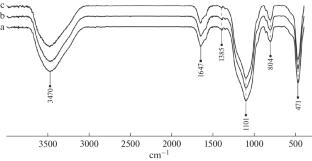机械化学活化法优化SiO2/Bi2O3混合物中生物源二氧化硅含量制备高效光催化剂
IF 0.6
4区 工程技术
Q4 ENGINEERING, CHEMICAL
引用次数: 0
摘要
Bi2O3/Bi2SiO5氧化物光催化剂是通过机械化学活化稻壳中氧化铋(III)和生物源二氧化硅的混合物得到的。利用红外光谱、x射线相分析和x射线荧光分析对材料进行了表征。利用描述甲基橙降解程度与Bi2O3-SiO2体系中SiO2含量关系的数学函数对光催化剂中二氧化硅含量进行了优化。本文章由计算机程序翻译,如有差异,请以英文原文为准。

Optimization of Biogenic Silica Content in SiO2/Bi2O3 Mixture for Obtaining Efficient Photocatalysts by Mechanochemical Activation Method
Bi2O3/Bi2SiO5 oxide photocatalysts are obtained by mechanochemical activation of a mixture of bismuth(III) oxide and biogenic silica from rice husks. The characteristics of the materials are presented using IR spectroscopy, X-ray phase analysis, and X-ray fluorescence analysis. The silica content in the photocatalysts is optimized using a mathematical function describing the dependence of the degree of methyl orange degradation on the amount of SiO2 in the Bi2O3–SiO2 system.
求助全文
通过发布文献求助,成功后即可免费获取论文全文。
去求助
来源期刊
CiteScore
1.20
自引率
25.00%
发文量
70
审稿时长
24 months
期刊介绍:
Theoretical Foundations of Chemical Engineering is a comprehensive journal covering all aspects of theoretical and applied research in chemical engineering, including transport phenomena; surface phenomena; processes of mixture separation; theory and methods of chemical reactor design; combined processes and multifunctional reactors; hydromechanic, thermal, diffusion, and chemical processes and apparatus, membrane processes and reactors; biotechnology; dispersed systems; nanotechnologies; process intensification; information modeling and analysis; energy- and resource-saving processes; environmentally clean processes and technologies.

 求助内容:
求助内容: 应助结果提醒方式:
应助结果提醒方式:


